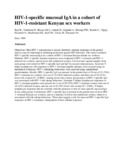| dc.contributor.author | Kaul, R | |
| dc.contributor.author | Trabattoni, D | |
| dc.contributor.author | Bwayo, JJ | |
| dc.contributor.author | Arienti, D | |
| dc.contributor.author | Zagliani, A | |
| dc.contributor.author | Mwangi, FM. | |
| dc.contributor.author | Kariuki C. | |
| dc.contributor.author | Ngugi, Elizabeth N | |
| dc.contributor.author | MacDonald KS. | |
| dc.contributor.author | Ball TB. | |
| dc.contributor.author | Clerici M. | |
| dc.contributor.author | Plummer FA. | |
| dc.date.accessioned | 2013-04-17T07:35:50Z | |
| dc.date.available | 2013-04-17T07:35:50Z | |
| dc.date.issued | 1999 | |
| dc.identifier.citation | AIDS. 1999 Jan 14;13(1):23-9 | en |
| dc.identifier.uri | http://www.ncbi.nlm.nih.gov/pubmed/10207541 | |
| dc.identifier.uri | http://erepository.uonbi.ac.ke:8080/xmlui/handle/123456789/16219 | |
| dc.description.abstract | Objectives: Most HIV-1 transmission is sexual; therefore, immune responses in the
genital mucosa may be important in mediating protection against HIV infection. This
study examined HIV-1-specific mucosal IgA in a cohort of HIV-1-resistant Kenyan
female sex workers.
Methods: HIV-1-specific immune responses were compared in HIV-1-resistant and
HIV-1-infected sex workers, and in lower risk uninfected women. Cervical and
vaginal samples from each group were tested for HIV-1-specific IgA and IgG by
enzyme immunoassay. Systemic T-helper lymphocyte cell responses to HIV-1
envelope peptide epitopes were assayed using an interleukin 2 bioassay. HIV-1 risktaking
behaviours were assessed using standardized questionnaires.
Results: HIV-1-specific IgA was present in the genital tract of 16 out of 21 (76%)
HIV-1-resistant sex workers, five out of 19 (26%) infected women, and three out of
28 (11%) lower risk women (P < 0.0001). Among lower risk women, the presence of
HIV-1-specific IgA was associated with HIV-1 risk-taking behaviour. Systemic
T-helper lymphocyte responses to HIV-1 envelope peptides were present in 11 out
of 20 (55%) HIV-1-resistant women, four out of 18 (22%) infected women, and one
out of 25 (4%) lower risk women (P < 0.001). T-helper lymphocyte responses did
not correlate with the presence or titre of virus-specific mucosal IgA in any study
group.
Conclusions: HIV-1-specific IgA is present in the genital tract of most HIV-1-
resistant Kenyan sex workers, and of a minority of lower risk uninfected women,
where it is associated with risk-taking behaviour. These data suggest a role for
mucosal HIV-1-specific IgA responses in HIV-1 resistance, independent of host
cellular responses. | en |
| dc.language.iso | en | en |
| dc.subject | Africa | en |
| dc.subject | HIV-1 resistance | en |
| dc.subject | Commercial sex workers | en |
| dc.subject | Genital tract, | en |
| dc.subject | Humoral immunity | en |
| dc.subject | Cellular immunity | en |
| dc.subject | Sexual behaviour | en |
| dc.title | HIV-1-specific mucosal IgA in a cohort of HIV-1-resistant Kenyan sex workers | en |
| dc.type | Article | en |
| local.publisher | Department of Medical Microbiology and Community Health, University of Nairobi, Nairobi, Kenya | en |
| local.publisher | Division of Infectious Diseases, Department of Medicine, University of Toronto, Canada, | en |
| local.publisher | The Cattedra di Immunologia, Universita degli Studi di Milano, Milan, Italy | en |
| local.publisher | Department of Medical Microbiology, University of Manitoba, Winnipeg, Canada | en |

